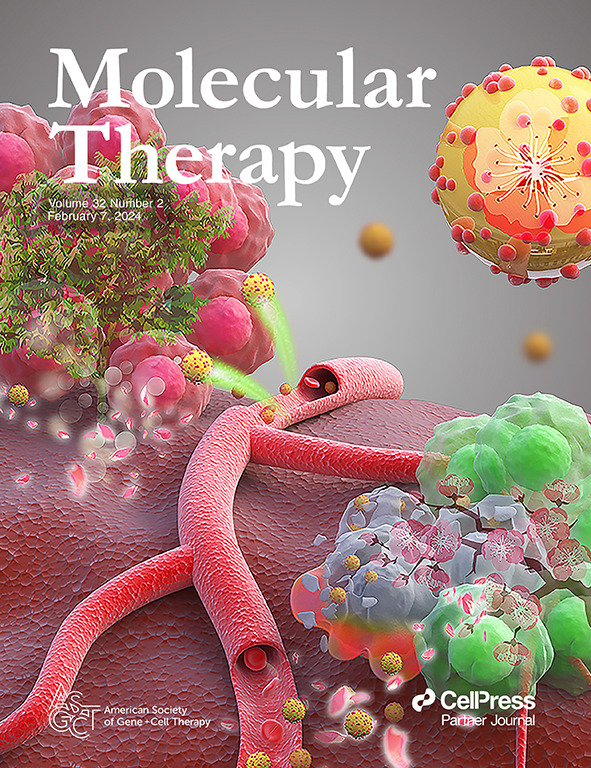Novel Photoreceptor-Specific Promoters for Gene Therapy in Mid-to-Late Stage Retinal Degeneration.
IF 12.1
1区 医学
Q1 BIOTECHNOLOGY & APPLIED MICROBIOLOGY
引用次数: 0
Abstract
Inherited retinal degenerations (IRDs) cause progressive photoreceptor loss, leading to vision impairment. Gene therapy using adeno-associated viral (AAV) vectors holds immense promise for treating these conditions. However, achieving optimal gene expression at mid-to-late stages of retinal degeneration remains challenging due to scarcity of efficient photoreceptor-specific promoters expressed at these disease stages. This study aimed to identify and validate novel promoters capable of robust and specific transgene expression when ≥ 50% photoreceptors are lost. Analysis of transcriptomic data from two naturally occurring canine IRD models, laser capture microdissection of retinal cryosections followed by qPCR, and RNA in situ hybridization identified six promising genes with sustained or upregulated expression in photoreceptors in late-stage disease. Upstream cis-regulatory elements of both canine and human orthologs were identified and characterized using in silico analyses and dual-luciferase assays. Short promoters (≤ 840 bp) derived from GNGT2, IMPG2 and PDE6H genes exhibited robust reporter gene expression in photoreceptors when delivered via AAV to the subretinal space of two non-allelic canine IRD models at mid- and late- disease stages. These findings provide a strategy to enhance AAV-mediated gene therapy by enabling sustained transgene expression in degenerating retinas, improving treatment outcomes for patients with progressive vision loss.用于中晚期视网膜变性基因治疗的新型光受体特异性启动子。
遗传性视网膜变性(IRDs)引起进行性光感受器丧失,导致视力障碍。使用腺相关病毒(AAV)载体的基因治疗对治疗这些疾病具有巨大的希望。然而,由于缺乏在这些疾病阶段表达的有效的光感受器特异性启动子,在视网膜变性中晚期实现最佳基因表达仍然具有挑战性。本研究旨在鉴定和验证当光感受器丢失≥50%时能够稳健和特异性表达转基因的新型启动子。对两种自然发生的犬IRD模型的转录组学数据进行分析,激光捕获视网膜冷冻切片显微解剖,然后进行qPCR和RNA原位杂交,鉴定出六个有希望的基因,这些基因在晚期疾病的光感受器中持续或上调表达。使用硅分析和双荧光素酶测定鉴定和表征了犬和人类同源物的上游顺式调控元件。来自GNGT2、IMPG2和PDE6H基因的短启动子(≤840 bp)在中晚期疾病阶段通过AAV传递到两种非等位犬IRD模型的视网膜下间隙时,在光感受器中表现出强大的报告基因表达。这些发现为增强aav介导的基因治疗提供了一种策略,通过使变性视网膜中的转基因持续表达,改善进行性视力丧失患者的治疗结果。
本文章由计算机程序翻译,如有差异,请以英文原文为准。
求助全文
约1分钟内获得全文
求助全文
来源期刊

Molecular Therapy
医学-生物工程与应用微生物
CiteScore
19.20
自引率
3.20%
发文量
357
审稿时长
3 months
期刊介绍:
Molecular Therapy is the leading journal for research in gene transfer, vector development, stem cell manipulation, and therapeutic interventions. It covers a broad spectrum of topics including genetic and acquired disease correction, vaccine development, pre-clinical validation, safety/efficacy studies, and clinical trials. With a focus on advancing genetics, medicine, and biotechnology, Molecular Therapy publishes peer-reviewed research, reviews, and commentaries to showcase the latest advancements in the field. With an impressive impact factor of 12.4 in 2022, it continues to attract top-tier contributions.
 求助内容:
求助内容: 应助结果提醒方式:
应助结果提醒方式:


